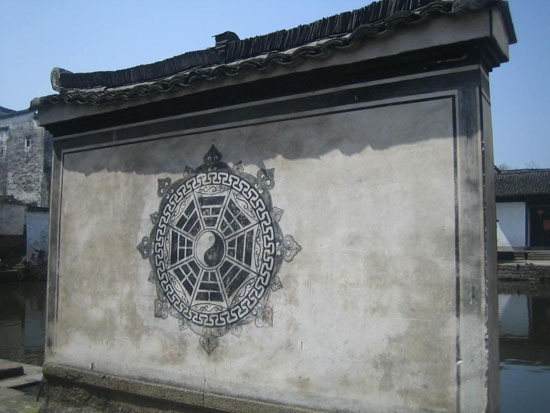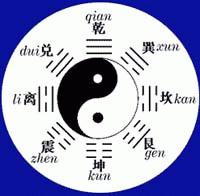
The eight diagrams (bagua) are used in Taoist cosmology to represent the fundamental principles of reality and all the creature.
In the bagua diagram, there are eight areas, or "guas," encircling the center. These nine different zones correspond to nine major areas of life.
There are two possible sources of bagua. The first is from traditional yin and yang philosophy. The interrelationships of this philosophy have been attributed to Fuxi, an ancient Chinese sage. Another philosophical description of the source is attributed to King Wen of Zhou Dynasty: “When the world began, there was heaven and earth. Heaven mated with the earth and gave birth to everything in the world. Heaven is qian-gua, and the Earth is kun-gua. The remaining six diagrams are their sons and daughters.”
The picture of the Ultimate consists of a black and a white fish---also called the yin and yang fish. The picture of the eight diagrams is an octagon formed of eight combinations of three whole or broken lines.

☰ 乾 qian, heaven/sky
☱ 兌 dui, lake/marsh
☲ 離 li, fire
☳ 震 zhen, thunder
☴ 巽 xun, wind
☵ 坎 kan, water
☶ 艮 gen, mountain
☷ 坤 kun, earth
According to legend, the picture was created by Fuxi, an ancient Chinese sage. It is written in the ancient book Zhou Yi (The Zhou Book of Changes) that “Changes originate in the Ultimate; form the Ultimate issue the two spheres. From the Ultimate spheres issue the four elements, and from the four elements the eight diagrams”. That was the basic theory of the Ultimate giving rise to the eight diagrams. By the Ultimate, the ancient meant the origin of all things and creatures.
The philosopher Zhu Xi (1130-1200) of southern Song Dynasty said, “The Ultimate is the way of all things in heaven and earth”. The two spheres refer to heaven and earth, or yin (feminine, negative) and yang (masculine, positive). The four elements are metal, wood, water, and fire, which are everywhere, and symbolized four seasons. The eight diagrams symbolize the eight natural phenomena: sky, earth, thunder, wind, water, fire, mountain and lake. So the picture represented the ancient Chinese's earliest knowledge of the universe, which contained a simple dialectical materialist point of view.
What is more interesting is the picture of the eight diagrams, which are formed of yao (lines), namely, the yangyao (male line, whole line written as —) and the yinyao (female line, a broken line written as --). The two forms are contradictory opposites and they from the eight combinations.
By taking two of them or doubling them, 64 combinations can be made.
It has been suggested that the German mathematician Wilhelm von Leibuiz (1646—1716) was inspired by the Chinese eight diagrams to create the binary system. If this was true, then the Chinese picture of the Ultimate and the Eight Diagrams made some historic contribution to the modern computer science.
In the early 1930's the Chinese scholar Liu Zihua, 27 years of age who was in France on a work-study basis, used the eight diagrams, without recourse to Newton's theory of gravity, to forecast the existence o the tenth planet of the solar system, and wrote a thesis entitled “The Eight Diagrams Theory of the Universe and Modern Astronomy”, which won him the French national doctorate in 1938 and thrilled the world astronomist profession.
The Chinese picture of the Ultimate and the Eight Diagrams is still being studied by some Western scholars as a source of ancient science. It is certainly an important heritage of Chinese science and culture, though at times it was used for divination and other superstitious activities.
Editor: Liu Fang
